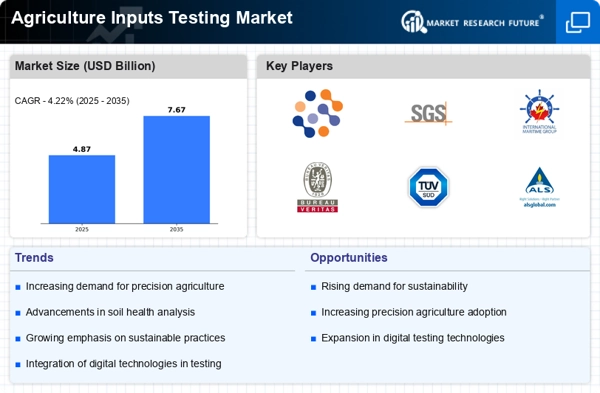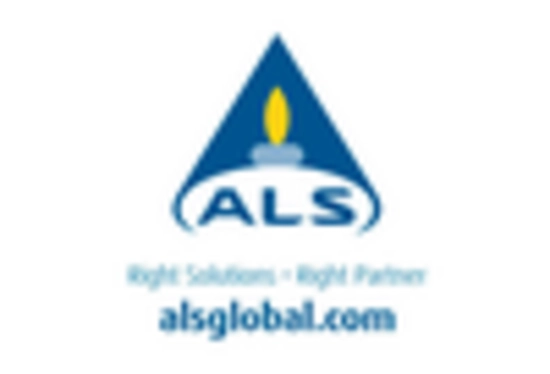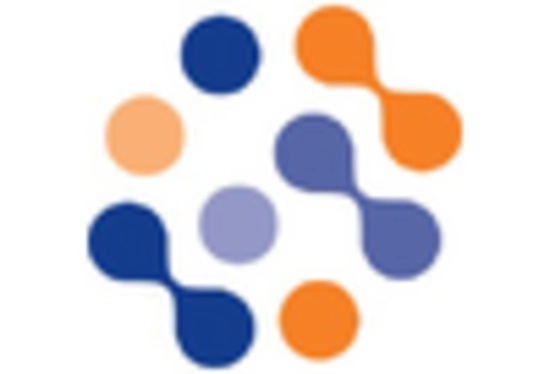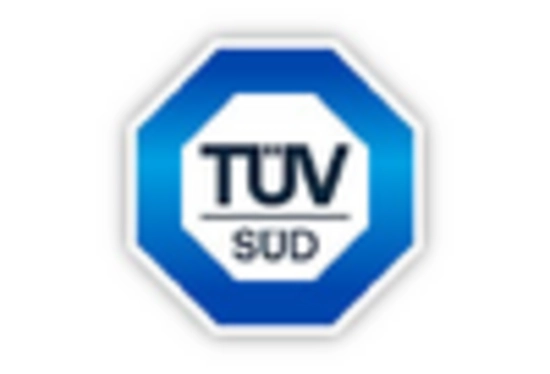Increased Regulatory Scrutiny
The Agriculture Inputs Testing Market is influenced by heightened regulatory scrutiny surrounding agricultural practices. Governments and regulatory bodies are implementing stricter guidelines to ensure the safety and quality of agricultural inputs. This trend is particularly evident in regions where food safety concerns have prompted legislative changes. In 2025, it is anticipated that the number of regulations governing agricultural inputs will increase, compelling producers to adopt comprehensive testing protocols. As a result, the demand for testing services is expected to rise, as stakeholders seek to comply with these regulations. This regulatory environment not only drives growth in the Agriculture Inputs Testing Market but also encourages innovation in testing methodologies to meet evolving standards.
Rising Demand for Food Safety
The Agriculture Inputs Testing Market is experiencing a notable increase in demand for food safety testing. As consumers become more health-conscious, the need for safe and quality food products intensifies. This trend is further supported by the growing awareness of foodborne illnesses and their impact on public health. In 2025, the market for food safety testing is projected to reach approximately USD 20 billion, indicating a robust growth trajectory. Consequently, agricultural producers are increasingly investing in testing services to ensure compliance with safety standards, thereby driving the Agriculture Inputs Testing Market forward. The emphasis on traceability and transparency in food supply chains also contributes to this rising demand, as stakeholders seek to validate the safety and quality of agricultural inputs.
Growing Organic Farming Practices
The shift towards organic farming practices is a significant driver of the Agriculture Inputs Testing Market. As consumers increasingly prefer organic products, farmers are adopting organic methods to meet this demand. This transition necessitates rigorous testing of inputs to ensure they comply with organic standards. In 2025, the organic food market is projected to reach USD 100 billion, further emphasizing the need for reliable testing services. The Agriculture Inputs Testing Market is thus positioned to benefit from this trend, as producers require testing to validate the organic status of their inputs. This growing emphasis on organic farming not only enhances market opportunities but also promotes sustainable agricultural practices.
Global Trade and Export Requirements
The Agriculture Inputs Testing Market is significantly impacted by the requirements associated with global trade and exports. As countries engage in international trade, the need for standardized testing of agricultural inputs becomes paramount. Exporters must comply with the testing and certification requirements of importing countries to ensure their products meet safety and quality standards. In 2025, it is estimated that the value of agricultural exports will exceed USD 1 trillion, highlighting the importance of testing services in facilitating trade. This dynamic creates a robust demand for testing solutions within the Agriculture Inputs Testing Market, as stakeholders seek to navigate complex regulatory landscapes and enhance their competitiveness in the global market.
Technological Innovations in Testing Methods
Technological advancements are significantly shaping the Agriculture Inputs Testing Market. Innovations such as rapid testing methods, automation, and artificial intelligence are enhancing the efficiency and accuracy of testing processes. For instance, the introduction of portable testing devices allows for on-site analysis, reducing the time required for results. The market for agricultural testing technologies is expected to grow at a compound annual growth rate of 8% from 2025 to 2030. These advancements not only streamline testing procedures but also improve the reliability of results, which is crucial for farmers and producers aiming to meet regulatory standards. As technology continues to evolve, it is likely to play a pivotal role in the Agriculture Inputs Testing Market, facilitating better decision-making and resource management.

















Leave a Comment